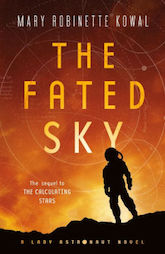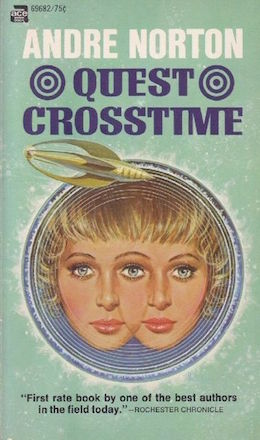This is a really interesting entry in the Norton canon. It’s a sequel to a pretty standard boys’ adventure, The Crossroads of Time, and Blake Walker rides the crosstime shuttles again, this time as an established wardsman. The book was published in 1965, and in the almost-decade between the two, science fiction was starting to change. For one thing, it had discovered girls.
It’s still Blake’s story. Every human with an important job, or any job at all really, is male. It’s still a man’s universe. And yet, there is an actual, living, breathing, more or less normal human female main character who gets a brief bit of viewpoint, and who has actual, real opinions and personality. She’s the first character we meet in fact, though once Blake arrives, the narrative immediately shifts to him, even at the end, when the story would have made a whole lot more sense if she had been allowed to tell it.
It’s a big step up from the heavily male-dominated universe of the previous volume, and Marfy (however unfortunate her name is) plays a significant role in the story. She’s the daughter of a powerful man on Vroom (oy, the naming here), Erc Rogan; Vroom is the central timeline in this universe, the one that invented crosstime travel and developed and maintains the wardsmen and their time-traveling machines. There’s a new political party in the mix, that aims to severely limit travel along the timelines. It’s led by a powerful demagogue, and Rogan is one of that would-be dictator’s strongest opponents.
Marfy and her twin sister Marva are among the vanishingly few females who are allowed to travel to more than a tiny handful of time levels. They’re the children of privilege, but they’re visibly competent. They’re also, at least in Marfy’s case, chafing severely against the restrictions on their gender.
We are given a reason for this. Vroom is one of the worlds almost destroyed by atomic war, and because all the warriors were male, they managed to survive in their bunkers whereas the women were nearly all killed off. The few who remained were heavily protected and prevented from doing pretty much anything but reproduce.
This is loosening up now, and the twins would like to see even more of that. They’ve been traveling as close to at will as possible, with their father’s encouragement. When the novel opens, they’re on a very unusual world, one that never developed life at all. We don’t get any explanation as to how a sterile world without plant life can have a breathable atmosphere, but it is an interesting concept.
There’s a Project in the works there, to try to terraform the planet and provide more space and resources for the people of Vroom. The twins are acting as interns of a sort—until Marva disappears. According to the tracking device every member of the Project carries, she’s fine, but Marfy’s twin telepathy says very much otherwise. As far as Marfy can tell, Marva is not even on this time level.
Blake arrives on a routine shuttle run to find that the communications setup has broken down, which means that there’s no way to get in contact with Vroom. Blake is put in charge of getting Marfy back home, but on the way, the shuttle gets derailed and they find themselves on an unknown world populated by giant intelligent turtles and little red lizard warriors.
They manage to escape after harrowing adventures and make it back to Vroom, but there’s still no sign of Marva. It seems she’s been kidnapped by persons unknown; she could be anywhere among a myriad time levels, but Marfy has an idea as to where she might be. She’s always been more rebellious than Marfy, and she’s fascinated by a particular world, one that is not open to tourism, though it’s a valuable source of trade and resources.
The situation at this point is incredibly complicated. There’s the politics of Vroom, with the Limiters screaming about shutting down all the crosstime travel but really wanting to shut down the Service with its regulations and restrictions and start pillaging worlds and enriching themselves in the process. Then there’s the politics of the world to which Marva has been taken, in which the European conquest of the Americas was minimal. There’s a small British presence, but most of North America is ruled by the Aztec Empire. As with Vroom, the empire is in a state of flux, with a weak ruler and an extremist faction on the rise. This faction wants to bring back the old rites of human sacrifice.
And that’s where Marva comes in. She’s being held by one of the extremist leaders, possibly to be sacrificed, but there’s more to it than that, as Blake and a small company of wardsmen discover when they show up undercover. Someone is using mind control on Marva—and that’s a Vroomian talent.
Marfy manages to track her twin down after a number of alarums and reversals, including a rather harrowing detour on Blake’s part. Unfortunately, the controller of minds is incredibly powerful and manages to control the entire team—except for Blake, who has an impenetrable natural shield. He manages to find the core of the conspiracy, aid in Marva’s rescue, and track the conspirators back to Vroom, where the leader has just about taken over.
This would-be dictator has been been shutting down the Service and marooning anyone who opposes him—as he does to Blake and the team. They end up back in the now dismantled Project, with nothing but air to breathe, water to drink, and a few stimulant pills. They have to figure out how to get to a timeline with actual food, before they all starve to death.
They think their way out of it, using the twins’ mental link with their father to break through the barrier between timelines and find their way to a resistance hideout. The remnants of the Service have gathered there, those who can escape before they’re marooned or killed. Rogan himself was wounded making his escape.
The rebels concoct a plot to eliminate the Limiters’ leader. Once he’s gone and his mind-controller is disposed of, they can take back Vroom and try to clean up the mess. A key element of this plan is Blake, who is immune to mind control. The Rogans, father and daughters, individually are not, but their combined mind powers, with some help, may be enough to overcome the controller.
They succeed, thanks to Blake, who manifests in the very nick of time as the perfect action hero. In the end, Vroom and the timelines are in a terrible mess, and we’re left to imagine what the good guys will have to do to fix it.
Buy the Book


The Fated Sky
There’s a lot going on here, between the concept of a sterile world, the alternate history with Aztecs, the populist rising on Vroom, plus all the various psi powers and their wielders both good and bad, the twin connection, and Blake’s peculiar gifts and background—we never do learn where he originally comes from, though there’a brief speculation that he must have been born in a world that bombed itself to death, and been sent to a safer timeline a la Kal-El. And then there’s the presence of functional female humans, who are not putting up quietly with the roles forced on them by their culture, and who are clearly and consistently competent.
Marva doesn’t have much to say. Mostly she’s either mind-controlled or traumatized. Marfy however just quietly gets stuff done. When it makes sense for her to sit down and let the guy do the rescuing, she does. She knows her limits, but she also knows what she can do. She doesn’t sit at home when there are worlds to save. She’s crucial to the resolution of all the various plots—without making a lot of noise about it. She just does it.
She’s a real step forward. By the mid-Sixties Norton had the Witch World going, and her best female protagonists were yet to come. Marfy is a harbinger of the likes of Maelen and Joisan and Simsa. She’s a pretty decent start.
I’ll be reading The Zero Stone next—thanks to the commenters who reminded me of it.
Judith Tarr’s first novel, The Isle of Glass, appeared in 1985. Her most recent novel, Dragons in the Earth, a contemporary fantasy set in Arizona, was published by Book View Cafe. In between, she’s written historicals and historical fantasies and epic fantasies and space operas, some of which have been published as ebooks from Book View Café. She has won the Crawford Award, and been a finalist for the World Fantasy Award and the Locus Award. She lives in Arizona with an assortment of cats, a blue-eyed dog, and a herd of Lipizzan horses.










